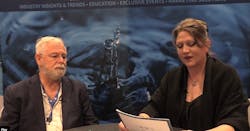April 13, 2001—States and the U.S. Environmental Protection Agency (EPA) have joined together to form a new state/EPA Non-point Source Partnership.
The partnership provides an excellent framework for states and EPA to work together cooperatively to identify, prioritize, and solve non-point source problems. The states and EPA initiated the new partnership at a national non-point source meeting sponsored jointly by The Association of State and Interstate Water Pollution Control Administrators (ASIWPCA) and EPA in April 2000.
Over the past several years, states have worked hard to "upgrade" their non-point source management programs, which were originally developed and approved in 1989 and 1990 under Section 319 of the Clean Water Act. The new Partnership is a timely endeavor to support the states in identifying and addressing their technical and programmatic needs in implementing their newly enhanced and upgraded non-point source programs.
The states and EPA have established seven work groups to focus on non-point source topic-specific needs, including: watershed planning and implementation; rural non-point sources; urban non-point sources; non-point source grants management; non-point source capacity building and funding; information transfer and outreach; and non-point source results. Each workgroup is comprised of a chair and co-chair (one EPA/one State), as well as other EPA and state representatives. A state/EPA Steering Committee, comprised of the chairpersons of each individual work group, has also been established to oversee the new Partnership effectively. Roberta Savage, Executive Director of ASIWPCA, and Elizabeth Fellows, Director of the Assessment and Watershed Protection Division at EPA, co-chair the Partnership's Steering Committee.
Each of the 7 work groups has identified its respective needs and priorities, and has developed individual action plans as to how it intends to address the priority needs over the next several years. Highlights of work group priorities include:
Watershed Planning and Implementation Workgroup. Strengthening the links between non-point source assessment and implementation activities by sharing examples of NPS total maximum daily loads (TMDLs)/watershed management approaches and related useful tools; and facilitating flexible approaches to watershed problem solving across EPA and other Federal/State agencies and programs.
Rural Non-point Sources Workgroup. Providing technical guidance to states in developing and implementing Comprehensive Nutrient Management Plans (CNMPs); surveying and facilitating the distribution of educational materials relating to Animal Feeding Operations and Confined Animal Feeding Operations (AFOs/CAFOs); and sharing information on rural best management practice (BMP) effectiveness and research gaps.
Urban Non-point Sources Workgroup. Identifying effective BMPs; and providing support for municipal stormwater program activities.
Non-point Source Grants Management Workgroup. Exploring options to streamline and simplify the 319 grant awards process; and developing/sharing examples of ways to enhance the involvement of local communities in non-point source activities with Federal and State financial support.
Non-point Source Capacity Building and Funding Workgroup. Researching successful state financial and program capacity building programs, identifying measures of success; and collecting good examples of effective state marketing tools.
Information Transfer and Outreach Workgroup. Identifying the best existing models of non-point source-related education materials, and developing recommendations on ways to integrate such models into school curricula; and conducting a media campaign to educate the general public about non-point source problems.
Non-point Source Results Workgroup. Enhancing state and national systems to enable the states and EPA to report more accurately and comprehensively to both Congress and the general public what is being accomplished through implementation of the non-point source program.
Additional fact sheets provide more detailed information on each of these 7 work groups.
The State/EPA NPS Partnership plans to communicate workgroup activities and accomplishments through active use of the periodical NPS News-Notes (which will soon be available on-line); non-point source list-servers; future EPA web site updates; interaction at stakeholder meetings; and other means.
Both EPA and ASIWPCA are excited about the new partnership, believing that this effort will capitalize on, benefit from, and support, the newly enhanced and upgraded non-point source management programs. Interest by the states and EPA is evidenced by the huge and active memberships that each of the 7 work groups have achieved. "By anticipating program needs and using our collective resources and expertise to address them in a coordinated manner, states and EPA will be able to greatly enhance non-point source management programs," states Roberta Savage, Executive Director of ASIWPCA.


